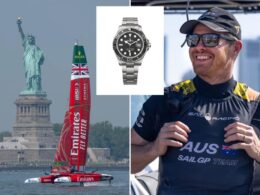Chiara Ferragni, a wildly glamorous fashion influencer who still boasts more than 28 million Instagram followers, was once a fixture on the Big Apple fashion scene.
At New York Fashion Week after New York Fashion Week, she would post pictures of herself sitting front row at coveted catwalk shows, cozying up to Karlie Kloss and “The Real Housewives of New York” star Rebecca Minkoff, and using landmarks like the Empire State Building as backdrops in enviable Instagram snaps shared with social media fans.
And when she donned a crocheted lace Christian Dior dress to marry Italian rapper Federico Leonardo “Fedez” Lucia in 2018, her extravagant wedding at a 19th-century Sicilian palazzo was featured in American Vogue, not to mention observed by a documentary film and reality TV crew.
But the 38-year-old Italian — who used her fame to build a fortune in the millions of dollars — has had a spectacular fall from grace and is now facing five years in prison after being indicted on charges of aggravated fraud in her home country.
She already appeared at the Court of Milan for pre-trial hearings on Sept. 23 and Nov. 4, with another court appearance set for next Tuesday, Nov. 25.
She’s been fined $1.27 million for conning the public into thinking she was selling Christmas treats for charity when the vast bulk of cash was going straight into her pockets (she paid an extra $1.39 million for a similar scheme over fake claims that Easter eggs would also underwrite a kids’ hospital).
The Italian government went further after those fines, though, charging her with aggravated fraud at a criminal trial this month in Milan. If she’s convicted, Ferragni could spend up to five years behind Italian bars.
Ferragni has gone from being the darling of Dior, Gucci and Versace, married to a famous rapper and earning up to six figures for a single Instagram post, to divorced, disgraced and seeing her company, Fenice Srl, make a loss of $6.65 million last year.
“She’s the Kim Kardashian of Italy,” Lauren Beeching, a crisis PR expert who specializes in sticky situations just like this, told The Post. “She’s super glamorous, business-minded and commercially unstoppable. At least until now.”
However, the prospect of a half-decade behind bars has not stopped the mother of two, who — rather than retreat gracefully until the trial has concluded — Ferragni instead swanned around fashion weeks this fall as usual, snapping pics and posting with her usual diligence. She also nabbed several glossy magazine covers, including Cosmopolitan España, Harper’s Bazaar Türkiye and Marie Claire México.
One fashion week invitation did not make the grid, though — her September pre-trial hearing.
But how did it get to this?
It was in 2009 that Ferragni first became famous for her blogging and bling, showcasing her flashy lifestyle as a student and earning enough attention to drop out of law school to focus on it full-time. Even then, she was canny enough to bleach her mousy brown hair to make her more notable – and fit her nickname.
“She’s the biggest ‘It’ girl in Italy, literally a household name, and she has a huge walk-in closet with hundreds of Chanel bags,” says Sophie Ross Brooks, co-host of the influencer-tracking “Snark Bait” podcast. “And they’re not even organized, just haphazardly thrown together. It’s, like, ‘Omigod, she’s so rich she doesn’t even have to worry about storing her Chanel bags carefully.’ ”
There wasn’t any aspect of her life she didn’t slavishly document on her Insta page, from her wedding to her two pregnancies, with her children eventually becoming fixtures on her platform.
Through the couple’s earnings, she built up a property portfolio — including a Milanese penthouse and a country retreat on Lake Como. Amazon Prime Italy tapped her entire family to anchor “The Ferragnez,” a hit “Keeping Up With the Kardashians”-style show about Chiara and her extended family, including her two lookalike sisters, Valentina and Francesca (the former is actually a natural blond).
It was all going so well that in 2020, she even considered a personal IPO, allowing fans to quite literally invest in their idol. By the end of 2022, her retail company Fenice Srl — offering women’s clothing, jewelry, kidswear, furniture and more — was worth around $87.5 million.
Then came #pandorogate — and a crash so extreme that she’s lost nearly 90% of that value.
It seemed so innocuous: For Christmas 2022, Ferragni announced yet another collab — this time, with Pillsbury-like baked-goods company Balocco, to sell a special festive cake, or pandoro, for charity.
It was three times pricier than a regular version, but worth every penny for the do-gooding baked in. All the proceeds, Chiara trilled, would go to support the Regina Margherita Children’s Hospital in Turin.
Almost immediately, Italian media were suspicious and, before the end of the year, had exposed the truth.
Balocco had donated some money to the hospital — $58,000 — albeit long before the cake went on sale. As for Chiara, she reportedly pocketed a cool million for her endorsement, or around 20 times what went to those sick kids. (An alleged fraud was repeated around a similar scheme with an Easter egg maker, where only $41,650 of the $1.39 million Chiara and the manufacturer reportedly earned went to charity.)
Chiara’s always-on Insta went dark as the Italian authorities began investigating. Eventually, she was fined $1.15 million, charged with aggravated fraud, and earned the dubious legacy of a statute change named in her dishonor: the Ferragni Law, which threatens fines on any charitable product that doesn’t make clear the exact percentage that will go to a good cause.
She finally acknowledged her con with a mea culpa Instagram Reel a year later, in December 2024. Almost makeup-free and penitent, she promised a personal donation of another million to the hospital.
Since then, things have gotten worse, not better: She’s weathered a messy public divorce — claiming that Fedez was unfaithful to her throughout their marriage and even offered to leave her at the altar — and tried to relegate the scandal to history by resuming her once-normal schedule, all while criminal charges loomed over her.
It doesn’t seem to be working.
“Her approach right now is pretty horrific,” crisis PR guru Lauren Beeching told The Post. “I would be pulling her out of the fashion-week circuit and pushing her to do independent audits and charity work. A complete shift in tone to less gloss and more realism.
“She could start again from the ground up,” Beeching suggested, which could include a move to another country.
A bigger problem, though, might be money.
OG influencers like Ferragni face an issue that their business model is outdated, at least according to Ryan Berger, who runs The Berger Shop, an influencer marketing shingle.
“There’s been a big change in the influencer space, going from mass to very, very targeted, which is why everyone wants to work with micro-influencers — they speak directly to their audience and they’re trusted.” Put another way: no brand wants to pay six figures to reach 28 million people but drive few sales when they could shell out $500 to a niche name that will nearly guarantee them.
Stateside, there are tighter regulations around influencing, courtesy of the Federal Trade Commission, which already made two-year rules even harsher starting this summer. It increased disclosure requirements, as well as liability for both brands and agencies alongside those content creators, making them all responsible for any infractions. It’s as granular as specifying the font size for disclosures at the start of any video (24 points, or the platform equivalent).
As for Ferragni-like fraud, that’s covered under standard statutes, but several states, including California and New York, are agitating for even stricter controls on alleged social media shilling like this. For instance, Golden State Gov. Gavin Newsom signed a law last month that aims to stop scammers from ripping off customers via unlabeled AI deepfakes.
Still, some say that notoriety can be monetized, when handled deftly, even in Ferragni’s favorite luxury space.
Barton Consulting’s Winston Chesterfield is one of them. He’s a guru of that high-end niche and says it can humanize endorsers — look at Jude Law’s messy private life, for example, which didn’t preclude him scoring Dior Homme and Brioni deals, among others.
“It depends on how serious it is, but luxury needs real characters — it can’t rely on models — so the idea brands don’t want to be associated with any kind of controversy? It’s not really true,” he explained. “Strong women who rise up again like a phoenix from the ashes get rewarded again.”
It all depends on how fierce a fire Chiara winds up facing, though.
Perhaps a Martha Stewart-style spell in the clink would be the best outcome for everyone, according to crisis expert Beeching.
“The influencer world isn’t playing by the rules, and they know they can get away with it,” she told The Post. “So this might be a bit of a lesson for everyone.”








